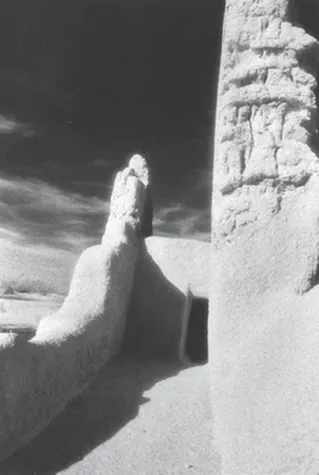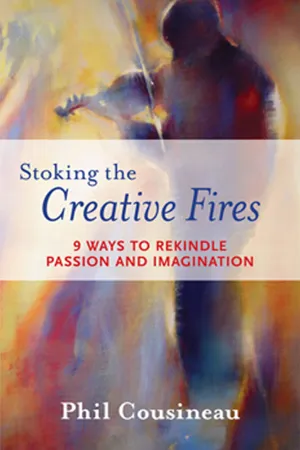![]()
PART I
Inspiration
And then there is inspiration. Where does it come from? Mostly from the excitement of living. I get it from the diversity of a tree or the ripple of the sea, a bit of poetry, the sighting of a dolphin breaking the still water and moving toward me, anything that quickens you to the instant. And whether one would call this inspiration or necessity, I really do not know.
—Martha Graham, Blood Memories
Casa Grande Ruins. Infrared photograph by Phil Cousineau, 2006.
Uroboros, medieval symbol of circularity, eternity, and self-knowledge. From Horapollio's Selecta Hieroglyphica, 1597.
![]()
CHAPTER 1
Fires of the Imagination
The artist must create a spark before he can make a fire and before art is born the artist must be ready to be consumed by the fire of his own creation.
—Auguste Rodin
Inspiration is a flash of fire in the human soul. Consider the marvel: the inrush of spirit, the flash of an idea, the flame of insight, the spark of imagination. It's the Aha, Eureka, and Hallelujah moment all rolled into one. Inspiration is a message-in-a-bottle from the distant shore, a window into the other world, a tap of the muse's finger, the grace of the gods. It comes when you least expect it, when your defenses are down and your vulnerability up. It arrives in a dream, a conversation, a brainstorm—and leaves without warning.
Inspiration is John Coltrane emerging out of a fourday silence with Love Supreme streaming through his soul. It's Pierre Bonnard running to the easel after seeing his wife bathed in golden light in their bathtub. It's Paul McCartney drifting off to sleep one night with the words “everyone lives in a yellow submarine” floating through his head. It's the New Yorker cartoon with the light bulb flashing over the head of the starry-eyed inventor.
Inspiration can also feel like a sudden possession. The mass hypnosis that came over Michelangelo and a group of fellow sculptors in Rome the day the Greek sculpture Laocoon was lifted out of the ground is illustrative of this fantastic aspect of inspiration, because it immediately compelled the entire group to draw it.
Sometimes softly, sometimes violently, sometimes sweetly, inspiration swoops down and compels us to express ourselves, the devil be damned. Suddenly, we're moved to speak our minds, like the ecstatic Chinese poet Li Po, who believed he was divinely inspired to write his travel poems and drinking songs; or Jane Austen, who was determined to write even after being banished to a tiny desk in the cramped hallways of the family home; or Rembrandt, who resorted to painting dozens of self-portraits when he ran out of money for models.
If inspired, the creative spirit takes wing, soars, surprises, blazes with radiance. “The glow of inspiration warms us,” Ovid wrote 2000 years ago, “and it is a holy rapture.” Allen Ginsberg said, “I write poetry because the English word inspiration comes from Latin, spiritus, breath, and I want to breathe freely.” “Who knows where it came from?” French philosopher Maurice Merleau-Ponty admits, “My own words take me by surprise and teach me what to think.” Singer Ani DiFranco sighs, “I have no idea where it comes from. It isn't fair.”
Inspiration: it's fascinating, enchanting, angrifying, exasperating, and elusive. If you try to pin it down, it squirms like Proteus, the Greek god of shapeshifting. It mocks your attempts to capture it with ropes of theory, keeping its secrets by slip-sliding away from you. If you deny it altogether and try to will your work into being without it, the work is recognized as “uninspired”—possibly the worst critique you can receive, because it insinuates you're mechanical, soulless. On the other hand, trying to force yourself to “be inspired” is like trying to think more clearly by squinting.
What you can do is be ready when the moment comes to work. You can be receptive, ready, and audacious.
Stephen King's On Writing is one of the best nononsense guides to the creative process in years. In it, he writes: “Let's get one thing clear right now, shall we? There is no Idea Dump, no Story Central, no Island of the Buried Bestsellers; good ideas seem to come from literally nowhere, sailing at you right out of the empty sky . . . Your job isn't to find these ideas but to recognize them when they show up.”
So inspiration may be an unpredictable friend, as inscrutable as an oracle and fickle as a weathervane. But if you're serious about your own creativity, you have no choice but to try to make it . . . well . . . scrutable, to salvage a wonderful old word. What you can do is improve the odds that your spirit will be moved by being alert to whatever form inspiration may take.
The recurring theme reflected in my own various passions—from the arts, to politics, to the spiritual life, to architecture, to baseball—is the ardent belief that the sparks of inspiration are everywhere. If I remain open to the wild fire they portend and don't hide behind the shutters of cynicism, sooner or later, one will ignite. In some still-elusive way, inspiration has to be both everywhere and everywhen, because it isn't a luxury for me. It's not a hobby; it's my life. Everything has to fit, sooner or later, into my insatiable desire to be creative or it feels like my life is backfiring.
For me, this means that I find inspiration in the rainbow flight of wild parrots over our house in San Francisco, the bells tolling from the church down the hill, the laughter of nursery-school kids walking in the rain, the lived-in face of an old Filipino newspaper seller, and the chance 1930s postcard stuck into one of my father's books. If I'm stuck, I look far and wide for the fires that will kindle my inspiration. My life revolves around this constant search. If I'm not on fire, I'm not inspired, and I can't work. If I force it, the work always sounds as if it's written in someone else's voice.
When asked what inspires me, I say, “Whatever sets my soul on fire.” That means travel, books, art, music, photographs, nature, or café conversation. Often as not, it's the ordinary wonders that do it—the sandal-maker, the mail carrier, or a cantoneiro, a sidewalk tile-setter I met in Lisbon years ago who felt he'd been given a gift from God in his ability to lay tile in beautiful, swirling black-and-white patterns. As I knelt to watch him work, I saw a glint in his eye that revealed devotion to his craft and gratitude for the gift he'd been given. That inner light has shone on in me till this day.
To immerse myself in the extraordinary, I seek out the paintings of Bonnard, the symphonies of Mahler, the sculptures of Henry Moore, the nature essays of Annie Dillard, the plays of Eugene O'Neill, the poetry of Philip Levine, the songs of Van Morrison, the slick lines of a '64 Mustang, and the lilt in my son's voice when he says, “Pop.” And I can't live without my daily dose of creative fire. Without it, I become neurotic—or grumpy, as my son tells me. But at least I know I'm not alone in this fierce desire. Seven hundred years ago Rumi told his followers: “Make friends with your burning.” Fifty years ago, jazz great Miles Davis was so lit up by Charlie Parker's he cried out, “I want his fire!”
However, caveat lector. Reader, beware. There are at least two kinds of inspiration. The first lifts your spirit, as spirituals and sunsets do. It makes you feel good, which isn't bad. But the second lifts your spirit and then flings you like a flaming arrow, full of passion and resolve to set the world on fire. This is the duende, the dark song in the gypsy soul, the black light that enflames the canvas, the spark that enlarges the heart. This is the blood surge that can be detected in the poems of Federico Lorca, the paintings of Edvard Munch, and the dances of Martha Graham. And it's combustible.
In this sense, inspiration is a gift from the back of beyond—a revelation of what separates us from all other species. We are moved to create, not out of brute instinct or biological necessity, but because we feel something so deeply we must respond, however carefully. Tchaikovsky describes this formidable force, in a letter dated from Florence, Italy, February 17 (March 1) 1878:
If that condition of mind and soul which we call inspiration lasted long without intermission, no artist could survive it. The strings would break and the instrument be shattered into fragments. It is already a great thing if the main ideas and general outline of a work come without any racking of brains, as the result of that supernatural and inexplicable force we call inspiration.
This isn't just shoveling smoke. It has everything to do with striving to express something—not off the top of your head, but from your fiery depths. Olympic gymnast Mary Lou Retton put it this way: “Each of us has a fire in our hearts for something. It's our goal in life to find it and keep it lit.” This goes for superb athletes, great artists, and also for rice farmers in the Philippines, brick-layers in Guatemala, teachers in Buffalo, and nurses in the Scottish Highlands. They can all teach you something about how to stoke the fires even under the harshest circumstances.
I'm trying to tell you something important here. The creative urge matters. Stories matter. Images matter. It matters that you were born with a genius, a guiding spirit, a daimon that may know more about your destiny than you do. It matters that there's an abyss between human hearts that can be bridged with ink, paint, stone, and music. It matters which words you use to bridge that chasm. “Stories,” “sparks,” “fires,” “genius,” “daimon,” “heart” are all sacred words in my vocabulary, because they do just that. But words aren't enough. You need something more, a spur that quickens you into action, a trigger that makes the phoenix in you rise from its ashes. You must make these words and desires move; you need to move beyond inspiration until it becomes something else.
The great Oregon poet William Stafford speaks of a mythic thread of destiny woven by the Three Fates: “There's a thread you follow. It goes among / Things that change. But it doesn't change . . . ”When in doubt about what you're supposed to be doing with your fierce heart, think about this thread. Is it your faith in the divine, your love of family, your vocation as a creative artist or entrepreneur? In this book, I will try to convince you to hold onto that thread as you enter the dark labyrinth of your incomplete work, no matter what your motivation.
HOLD ONTO THE THREAD
This much I know. The creative journey is a search for the deeply real. It's a fiery attempt to make real some idea, some vision that is uncomfortably unreal until it's created. The search for inspiration, like Stafford's mythic thread, is neverending. The thread is the force that makes you real—if you don't let go of it. Your work will never be real—realized—until you are.
Here is a very real description of inspiration given by ten-year-old Nila Devaney, from Arcata, California:
Inspiration is...



